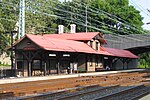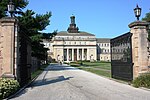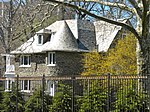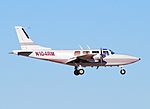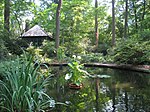Merion Station, Pennsylvania
1695 establishments in PennsylvaniaAC with 0 elementsLower Merion Township, PennsylvaniaPennsylvania Main LinePopulated places established in 1695 ... and 2 more
Unincorporated communities in Montgomery County, PennsylvaniaUnincorporated communities in Pennsylvania

Merion Station (also known as Merion) is an unincorporated community in Pennsylvania, United States, bordering Philadelphia to the city's west. It is one of the communities that make up the Philadelphia Main Line, and is part of the municipality of Lower Merion Township, Montgomery County. Merion Station is known for its grand mansions and for the wealth of its residents. Merion Station is contiguous to the Overbrook and Overbrook Park neighborhoods of Philadelphia and is also bordered by Lower Merion Township's unincorporated communities of Wynnewood and Bala Cynwyd, and the borough of Narberth.
Excerpt from the Wikipedia article Merion Station, Pennsylvania (License: CC BY-SA 3.0, Authors, Images).Merion Station, Pennsylvania
Merbrook Lane, Lower Merion Township
Geographical coordinates (GPS) Address Nearby Places Show on map
Geographical coordinates (GPS)
| Latitude | Longitude |
|---|---|
| N 39.993333333333 ° | E -75.251111111111 ° |
Address
Merbrook Lane 91
19066 Lower Merion Township
Pennsylvania, United States
Open on Google Maps
